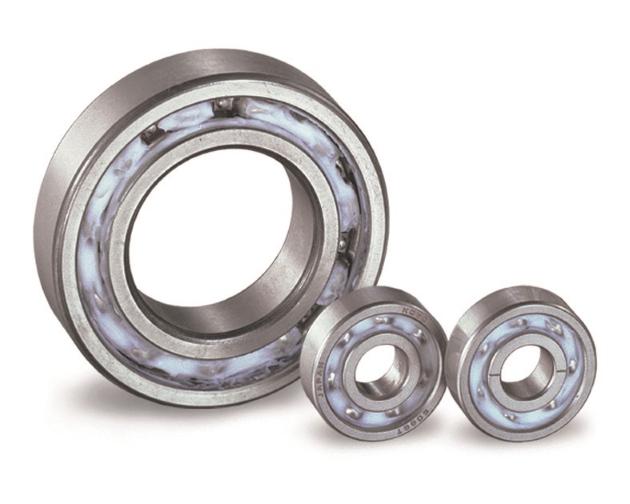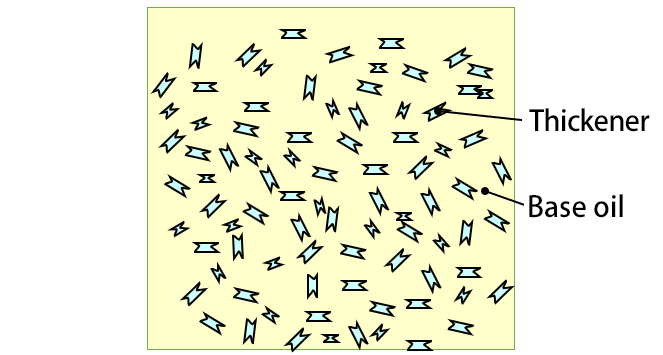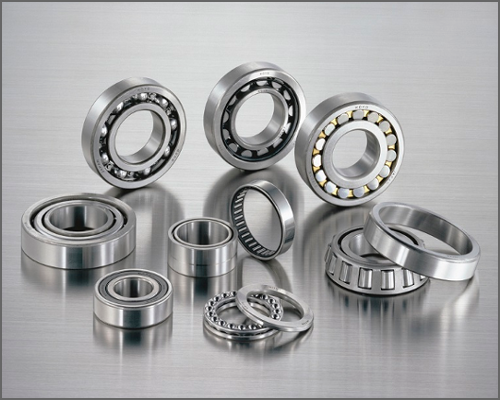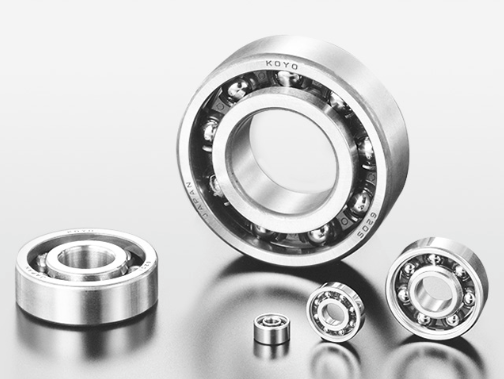Bearing Trivia
Bearing Trivia for Beginners 5: "Bearing Grease"
- Bearing Trivia for Beginner
To the readers of Bearing Trivia,
Your Bearing Trivia reporter, Mr. X here!
A bearing is a component used in a great many machines that rotates smoothly while supporting a load (force). Lubrication plays a major role in facilitating the stable and smooth rotation of the bearing. Many general-purpose bearings use grease as a lubricant, and it is no exaggeration to say that the performance of the bearing is determined by the type of grease used.
This entry will introduce the properties required of bearing grease.
1.What is bearing lubrication?
As shown in Table 1, the major types of bearing lubrication are: grease lubrication, which uses semi-solid (i.e., like cream) grease; and oil lubrication, which uses lubricating oil.
Table 1 : Major types of bearing lubrication
| No. | Item | Grease lubrication | Oil lubrication |
|---|---|---|---|
| 1 | Sealing device | Simple | Slightly troublesome Care needs to be taken for the maintenance of the device |
| 2 | Lubricating ability | Good | Excellent |
| 3 | Rotational speed | Low/medium speed | Can be used in high-speed rotation |
| 4 | Replacement of lubricant | Slightly troublesome | Simple |
| 5 | Life of lubricant | Relatively short | Long |
| 6 | Cooling effect | No cooling effect | Good (but circulation is needed) |
| 7 | Filtration of dirt (removal of foreign matter) |
Difficult | Effective |
Generally speaking, oil lubrication is more effective as a lubricant than grease lubrication, and so is used in situations where such factors as high-speed rotation, a large cooling effect, or dirt filtering are required. However, liquid lubricants tend to leak, requiring complex sealing devices to contain them.
Click here for sealing devices.
On the other hand, using grease lubrication in the form of semi-solid (i.e., like cream) lubricating oils can prevent leakage. Grease lubrication therefore simplifies the sealing structure, in turn simplifying the machine structure. Furthermore, simplified sealing structures reduce the frequency with which machine maintenance and inspection must be performed.
In particular, the grease-packed bearing shown in Figure 1 is easy to handle and is used in many types of machines.
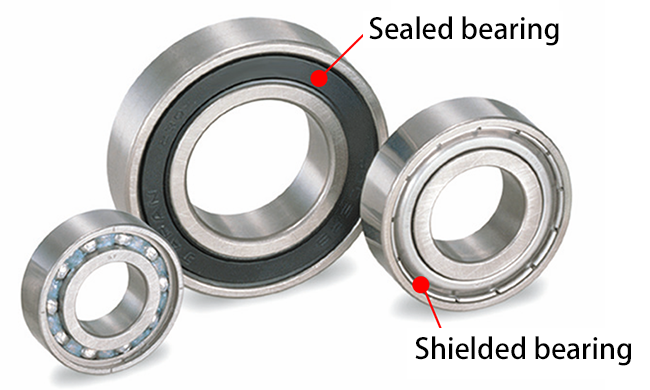
Figure1: Grease-packed bearings
2.1. What is grease?
As shown in Table 2, grease ingredients include a (1) thickener, (2) base oil (lubricating oil), and (3) additives. Optimal grease for bearing applications is created by adjusting and blending these ingredients and their amounts.
Table 2 : Grease ingredients and their roles
| Ingredient | Role | |
|---|---|---|
| Grease | Thickener | Disperses in base oil and retains oil to make it semi-solid (determines characteristics such as operating temperature range and mechanical stability) |
| Base oil (lubricating oil)1) | Oil with excellent lubricating ability | |
| Additives | Complements performance according to the application (e.g., withstanding heavy loads/impact loads, preventing heat degradation, preventing rust) |
|
[Note] 1) The lubricating oil used as a raw material for grease is called "base oil."
1) Thickener
The thickener is a solid ingredient that disperses throughout the base oil, enabling it to be retained.
As shown in Figure 2, the main types of thickeners used have very small fibers with a length of several μm (micrometers)1)and a thickness of several tens to hundreds of nm (nanometers)2).
Notes: 1) 1 μm=0.001 mm
2) 1 nm = 0.001 μm = 0.000 001 mm
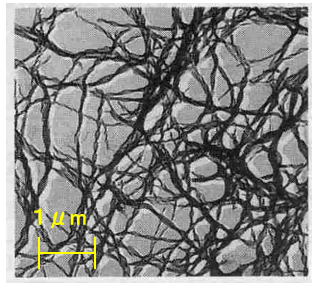
Figure 2 : Electron micrograph of thickener fibers
As shown in Figure 3, before a bearing rotates (when it is stationary), the thickener becomes tangled in a mesh shape to retain the base oil.
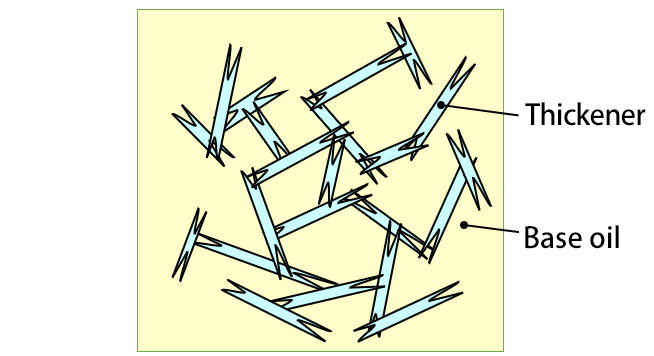
Figure 3:Mesh-shaped thickener
When a bearing rotates, shearing occurs between the rolling elements (balls or rollers) and the bearing ring (or race in the case of thrust bearings) which, as shown in Figure 4, causes the mesh-shaped thickener to become untangled and oriented in the same direction. This orientation enables the bearing to rotate smoothly with little force.
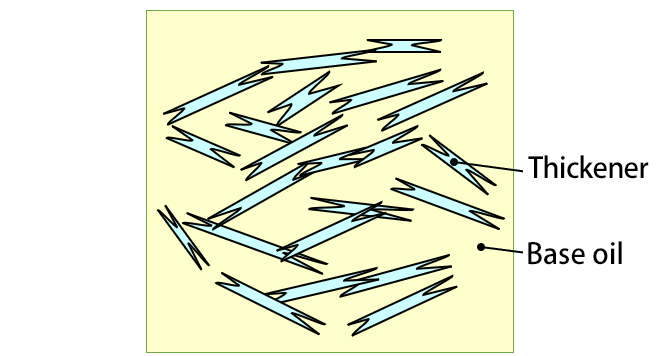
Figure4:Oriented thickener
As shown in Figure 5, when a bearing does not rotate for some time, the thickener returns to a mesh shape, preventing the base oil from leaking.
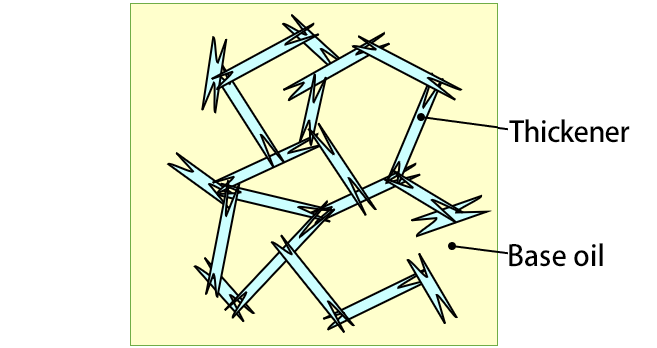
Figure 5:Thickener returned to a mesh shape
As shown in Figure 6, if the thickener is subjected to heavy shear or undergoes heat degradation, it breaks down and loses its ability to retain the base oil.
Figure 6:Broken down thickener
The ingredients used for thickeners should not only be compatible with the base oil, but should also have good lubricating ability. When thickeners are highly compatible with the base oil, only a small amount is required to retain a large amount of base oil.
Table3 shows the main types of thickeners used in bearing grease.
Table 3: Main types of thickeners used in bearing grease
| Type of grease | Thickener |
|---|---|
| Metallic soap base grease | Lithium soap |
| Calcium soap | |
| Sodium soap | |
| Non-soap base grease | Urea compounds |
| Fluorine compounds |
Among these, lithium soap has the widest range of uses, as its fibers are resistant to breakage even when exposed to water or high temperatures, or when subjected to shearing during bearing rotation. Chemically stable urea compounds are also used as thickeners in high-temperature bearing grease.
There is a close relationship between the concentration (amount) of the thickener and the hardness of the grease, in that less thickener will result in softer grease, while more thickener will result in harder grease. The hardness of grease is measured using an index called "consistency." As shown in Figure 7, this "consistency" is expressed as the depth (mm) in which a specified cone-shaped metallic plunger penetrates under its own weight in 5 seconds multiplied by 10, with the higher the penetration value, the softer the grease.
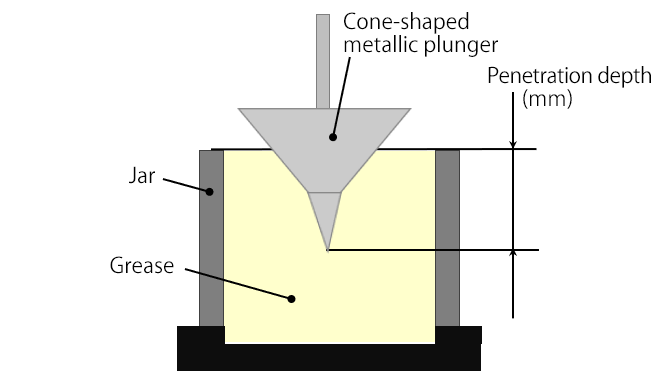
Figure 7:Consistency measurement method
2) Base oil (lubricating oil)
Table 4 shows major types of base oils and their properties.
Table 4: Types of base oils and their properties
| Type | Advantages | Disadvantages |
|---|---|---|
| Mineral oil (distilled and refined from petroleum) |
• Relatively inexpensive and good lubricating ability | • Suffers decreased lubricating ability due to impurities that cannot be purified (degradation (quality changes) at high temperatures, high viscosity at low temperatures) |
| Synthetic oil (made by chemical reactions) |
• Does not easily degrade (undergo changes in quality) at high temperatures due to its chemical stability and lack of impurities • Enables grease to be used in a wider temperature range than mineral oil due to its low level of viscosity changes between high and low temperatures |
• High in cost |
Generally speaking, mineral oil is often used as the base oil for grease.
However, synthetic oils are used for grease that requires stability at high temperatures and fluidity at low temperatures.
3)Additives
Additives provide properties that cannot be achieved with thickeners and base oils alone.
Additives serve the purpose of:
(1) Enhancing the lubricating ability of grease
(2) Protecting against grease heat degradation (quality changes) and improving durability
(3) Protecting against rust
Etc.
3. Properties required of bearing grease
Table 5 shows the main properties required of bearing grease and examples thereof.
Table 5: Properties required of bearing grease and examples thereof
| No. | Required property | Example of required property |
| 1 | Temperature properties | Ensured lubricating ability across a wide temperature range according to the application Ensured stability at high temperatures Ensured fluidity at low temperatures |
| 2 | Durability | Ensured lubricating ability of grease over a long period |
| 3 | High-speed performance | Suppression of temperature increases during high-speed rotation |
| 4 | Noise properties | Quietness during bearing rotation |
1)Temperature properties
Although bearings have a variety of applications, the temperature range for which they are compatible is largely determined by the grease used. Grease for bearings used at high temperatures combines a urea compound thickener and synthetic oil, which is both chemically stable and resistant to degradation even at high temperatures.
On the other hand, grease for bearings used at low temperatures uses a base oil with excellent fluidity to prevent it from solidifying at low temperatures and causing bearing rotation to stop.
2) Durability
Automotive applications require a level of durability that enables continued lubrication over the service life of the vehicle with only a small amount of grease. For this reason, grease containing many types of additives in addition to thickeners and base oils is used to suppress grease degradation and bearing wear.
3)High-speed performance
Bearings that rotate at high speeds require grease that suppresses increases in temperature. For this reason, it is necessary to reduce any resistance to grease agitation caused by bearing rotation. As shown in Figures 8 and 9, bearings that rotate at high speed require that the grease be adjusted and blended in a manner that enables the base oil to gradually ooze out from the grease exuded from the rolling surface as the bearing rotates.

a) Grease that easily oozes base oil b) Grease that does not easily ooze base oil
Figure8 : Grease agitation caused by bearing rotation
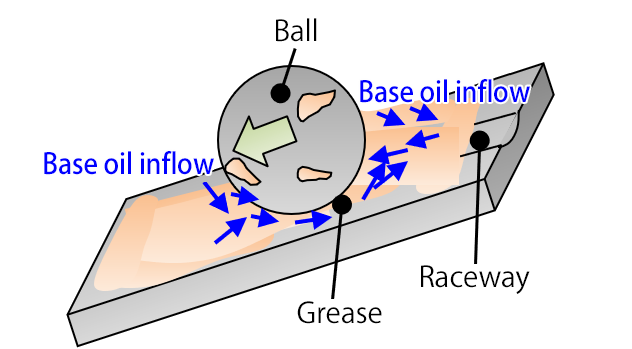
Figure 9: Mechanism by which base oil oozes out from exuded grease
4)Noise properties
Bearing grease must ensure quietness during rotation.
As shown by the red circles in Figure 10, thickeners in grease exist in the form of clumps measuring several to tens of micrometers in size, and which are intertwined with fibers.
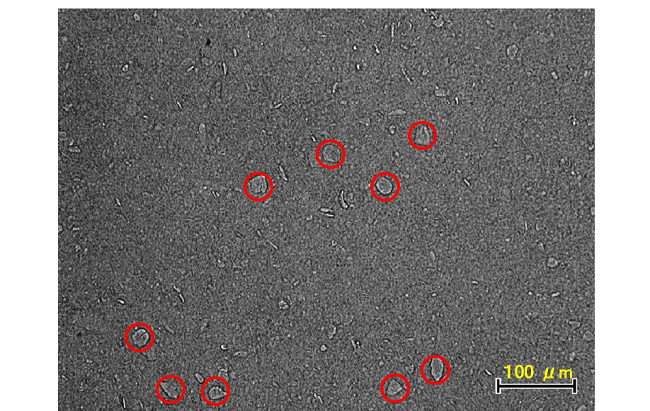
Figure 10 : Thickener clumps
When a bearing rotates, rolling elements (balls or rollers) pass through these clumps, causing the bearing to vibrate and noise to be generated. For this reason, "rolled" grease is used, in which large clumps of thickener are ground up and finely dispersed.
4. Conclusion
- Using grease in the form of semi-solid (i.e., like cream) lubricating oils can prevent leakage. Grease-packed bearings are easy to handle and are used in many types of machines.
- Grease ingredients include a (1) thickener, (2) base oil (lubricating oil), and (3) additives, with grease suitable for bearing applications being created by adjusting and blending these ingredients and their amounts.
- Grease has been developed that provides the properties (e.g., temperature properties, durability, high-speed performance and noise properties) necessary to enhance bearing performance.
In addition to the types of grease lubrication introduced here, there are also solid lubricants. We encourage you to check these out as well.
Bearings Made Using Advanced Materials and Lubricants: Bearings all around you
How to Select the Right Bearing for Extreme Special Environments (EXSEV Bearings) (Part 1): Materials and lubricants
